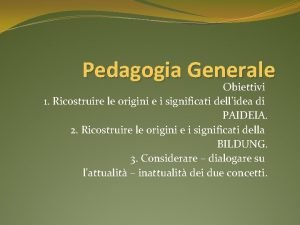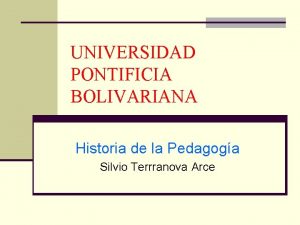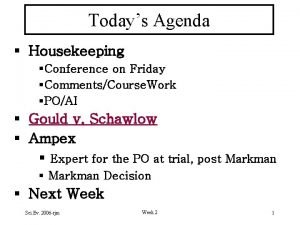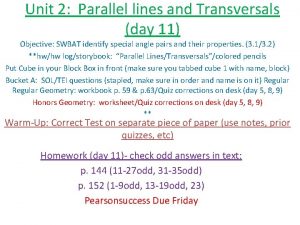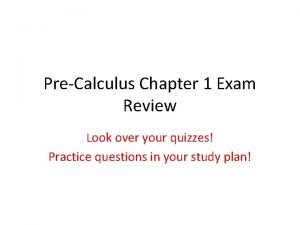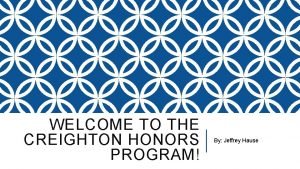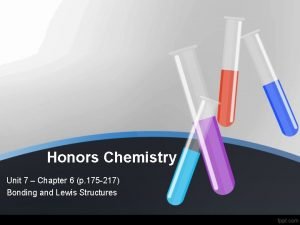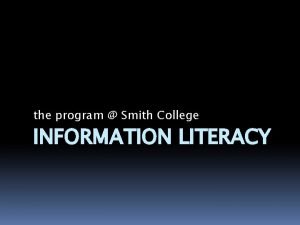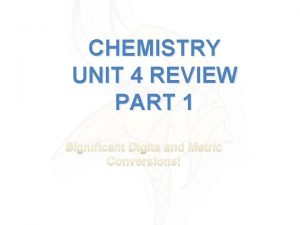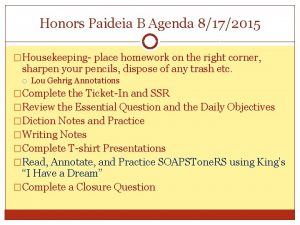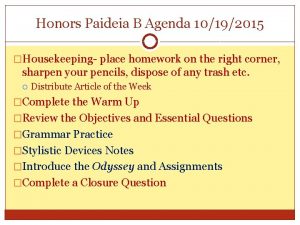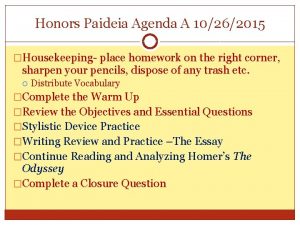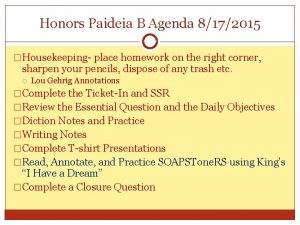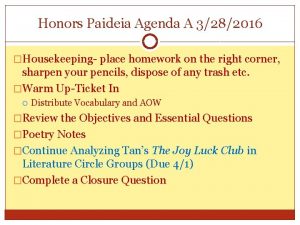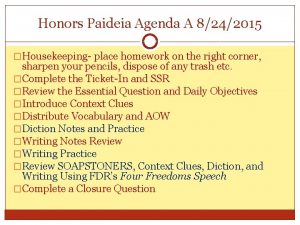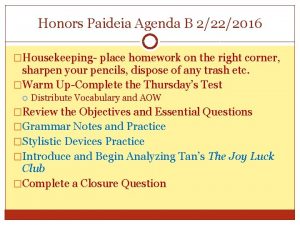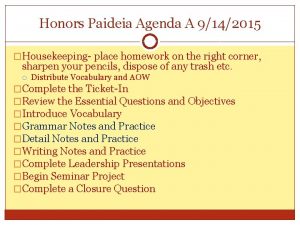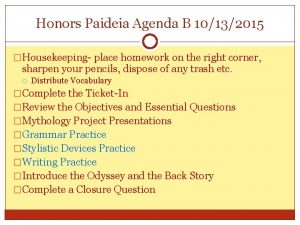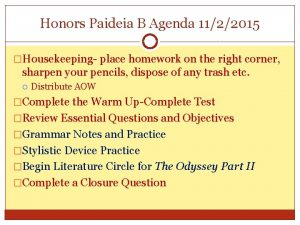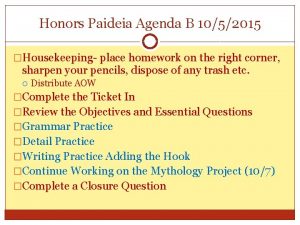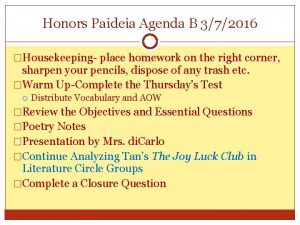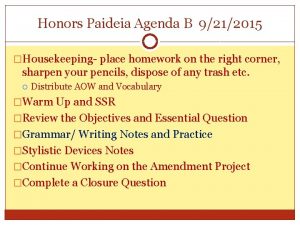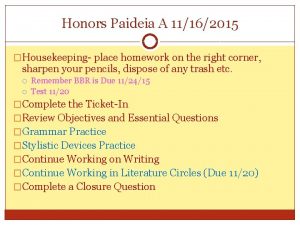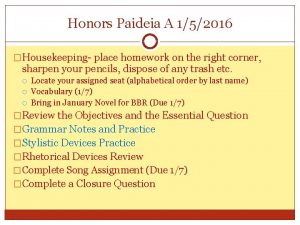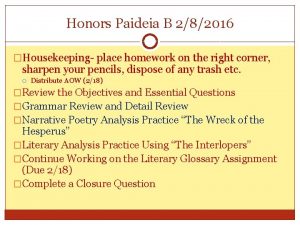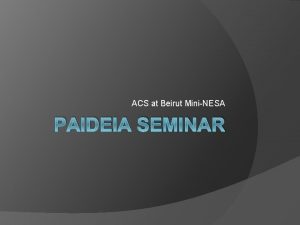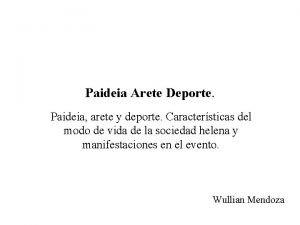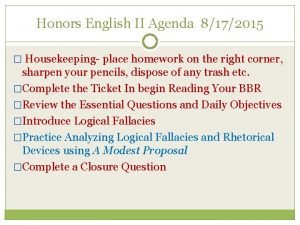Honors Paideia Agenda A 9282015 Housekeeping place homework





















- Slides: 21

Honors Paideia Agenda A 9/28/2015 Housekeeping- place homework on the right corner, sharpen your pencils, dispose of any trash etc. Distribute Vocabulary Warm Up-Complete the Ticket In Review the Objectives and Essential Questions Review Rhetorical Devices Stylistic Devices Notes Review Noodle Tools Introduce Mythology Project (10/8) Complete a Closure Question

Honors Paideia Agenda B 9/29/2015 Housekeeping- place homework on the right corner, sharpen your pencils, dispose of any trash etc. Distribute Vocabulary Warm Up-Complete the Ticket In Review the Objectives and Essential Questions Review Rhetorical Devices Stylistic Devices Notes Review Noodle Tools Introduce Mythology Project (due 10/7) Complete a Closure Question

Let’s Review the Basics Plot-Plot is the sequence of events in a story. Exposition- the beginning of a fictional text that introduces characters, setting, and situations. Conflict- the struggles characters Rising Action- adds complications to the conflict and leads to the Climax- the point of highest emotional involvement Falling Action- presents the results of the climax Resolution- gives the final outcome. Characterization-how the author develops a character Direct-The writer or narrator simply tells the reader about a character Indirect- The writer gives clues to a character by presenting the character’s actions words, and thoughts and by showing how others react to the character. Setting-The setting is the time and location of the action in a story Theme-The central message or insight into life in a literary work. Allusions-A reference in a work of literature to a character, place, or situation from another work of literature, music or art.

SOAPSTone. RS with Fiction Subject-Theme Occasion- Setting Audience- To whom the author is communicating Purpose- Usually to critique/entertain (pay attention to the tone) Speaker- NEVER the author (reliable/unreliable narrator) Tone-The author’s feeling toward the subject or audience Rhetorical Devices- Diction, Details, Antithesis, Repetition, Parallelism Stylistic Devices- Usually called Literary Devices (Imagery, Characterization, Metaphor, Simile, Personification, etc. (A device can be rhetorical or stylistic depending on how it is used)

Rhetorical Devices Review Rhetorical Devices-use of language that is intended to manipulate the audience. The meaning however is literal/not figurative. Diction-the author’s choice of words (it is foundational to all other stylistic (literary) and rhetorical devices Antithesis-a form of parallelism in which two opposite ideas are put together in a sentence to achieve a contrasting effect Parallelism-the use of components in a sentence that are grammatically the same. This method adds balance and rhythm to sentences giving ideas a smoother flow and thus can be persuasive because of the repetition it employs Repetition- repeating a word or phrase to provide emphasis Details – Help to focus the reader’s attention on important ideas and shapes the reader’s understanding and view of a topic. In Nonfiction-IT INCLUDES FACTS, OBSERVATIONS, REASONS, EXAMPLES, QUOTATIONS, AND INCIDENTS In Fiction- It is imagery-details that created a clear mental picture for the reader by focusing on particulars rather that abstractions

Stylistic Devices are also know as Figurative Language/Literary Devices Figurative language is any language that is NOT used in a literal (meaning exactly what it says) way. It is a way of saying one thing and meaning another. We use figurative language, or figures of speech all of the time. For example, at a baseball game we may say: That catcher was the heat! That ball sat in the outfield. Jimmy ran like a cheetah to first base. If we look at these statement literally, they make no sense at all. (A person is heat, a ball can’t sit, and Jimmy is not a cheetah) Even though the statement make no literal sense we understand them. We know that when we say the catcher is the heat- we man he is skilled, practices, and maybe cute too. We use figurative language because it is rich, strong, and a vivid way to express meaning. Consequently, we are able to say much more in fewer words. When it is over used, however it becomes an cliché (a stale and overused expression) Example: pretty as a picture and quiet as a mouse.

We will begin with metaphors, similes, and personification Metaphors and similes are used to compare things that are not usually seen as similar. Metaphors imply the comparison, and similes state the comparison directly. Example: The test was a bear! You are not saying that it was a literal bear but that it was unpredictable and hard to deal with. The comparison between the test and bear is not directly stated. Instead, the comparison is implied or suggested. You identify the bear with the test. That’s what a metaphor does. A metaphor implies a comparison in order to bring fresh, rich meaning to writing and speaking.

Similes Simile is a comparison, too. With a simile, however, the comparison is directly stated. The writer makes the comparison explicit. The test was like struggling with a bear. It is still non-literal language (taking the test is not really like struggling with a bear) but with a simile you come right out and state the comparison. Similes have a signal word that give you a hint a simile is coming. These words include as, like, than, similar to, and resembles. Be careful these words don’t always indicate similes. I look like my sister is not using a simile it is a literal. To be a simile or metaphor, the comparison must be of essentially unlike things.

Metaphors and Similes Metaphors and similes have literal terms and figurative terms. The literal term is what we are comparing to something else. It’s what’s real: it means what it is. For example the literal term in the metaphor, that test was a bear is test. We are really talking about a test. The figurative term is what is being compared to the literal term. The figurative term means something other than itself, something non literal. The figurative term in the metaphor is bear. The test is not a bear, but it has some bear-like qualities that can help us understand just how hard the test was.

Metaphor vs. Simile Figure of Speech Metaphor or Simile? I got a flood of mail yesterday. Alice sang like a crow. Jeff was taller than the Empire State Building. The shoes cost a king’s ransom. Literal Term Figurative Term

Personification is a special kind of metaphor that gives human qualities to something that is not human, such as an animal, an object, or an idea. The tree sighed sadly in the cold- we are using personification. A tree can’t really sigh or be sad. We are giving the tree characteristics of a person. Personification, since it is a kind of metaphor, has a literal and figurative term. In the example above, the literal term is the tree (it is really a tree) and the figurative term is a person (the tree is not really a person who can sigh and be sad). In personification the figurative term is always a person.

Practice writing examples of metaphors, similes, and personification for the literal terms below. Literal Term Possible Figurative Terms Metaphor Simile Personificati on Friendship Lea’s friendship is a lighthouse. Lea’s friendship is like a lighthouse. Lea’s friendship wrapped my sadness in a warm blanket Cleaning your room Shirt Cafeteria lunch Dancing Lighthouse, warm blanket

Respond to the Following What did you learn about yourself the last time we worked in groups? What norms do you need to create to make sure you and your group/partner collaborate well, create quality work, and submit it on time? Consider: Who will facilitate the discussion? What are the expectations regarding submitting work? Establish how you will reach consensus. What will you do when you disagree with one another? Time line for completing tasks. Individual responsibilities Contact information

Honors Paideia Agenda 9/30/2015 Housekeeping- place homework on the right corner, sharpen your pencils, dispose of any trash etc. Vocabulary Complete the Ticket-In Review the Objectives and the Essential Questions Grammar Practice Stylistic Devices Practice Continue Working on the Mythology Project Complete a Closure Question

Honors Paideia Agenda B 10/1/2015 Housekeeping- place homework on the right corner, sharpen your pencils, dispose of any trash etc. Vocabulary AOW Complete the Ticket-In Review the Objectives and the Essential Questions Grammar Practice Stylistic Devices Practice Continue Working on the Mythology Project Complete a Closure Question

Identify the conjunctions, independent, and dependent clauses in each sentence. Then indicate if the sentence is a correct or a fragment. If it is incorrect, then correct the sentence. Bucking a Washington tradition, some politicians have willingly left office to pursue new interest. Pat Schroeder and J. C. Watts among them. 2. People suffer from many peculiar phobias. For example hydrophobia, aviophobia, and vestiphobia. 3. The technology of computer animation has developed rapidly over the past decade; making a spectacular range of special effects possible. 4. Yellowstone is the oldest of America’s national parks, it is located in Wyoming. 1.

Stylistic Devices Practice “I was seven, I lay in the car/ watching palm trees swirl a sickening pattern past the glass. / My stomach was a melon split wide inside my skin. ”- Nye, “Making a Fist” 1. What is the metaphor in this poem? What is the literal term? What is the figurative term? What does the metaphor mean? 2. How would the meaning and impact of these lines change if Nye simply said, My stomach really hurt? 3. Rewrite the figurative term in Nye’s metaphor. Try to express feelings of anxiety and pain- both physical and emotional with your metaphor. My stomach was_______________

Honors Paideia A 10/2/2015 Housekeeping- place homework on the right corner, sharpen your pencils, dispose of any trash etc. AOW Complete the Ticket In Review the Objectives and Essential Questions Grammar Practice Detail Practice Continue Working on the Mythology Project Complete a Closure Question

Honors Paideia Agenda B 10/5/2015 Housekeeping- place homework on the right corner, sharpen your pencils, dispose of any trash etc. Complete the Ticket In Review the Objectives and Essential Questions Grammar Practice Detail Practice Writing Practice Adding the Hook Continue Working on the Mythology Project Complete a Closure Question

Identify the conjunctions, independent, and dependent clauses in each sentence. Then indicate if the sentence is a correct or a fragment. If it is incorrect, then correct the sentence 1. 2. 3. 4. 5. At the edge of a grove of pine trees; we pitched our tent on the north side of the lake. My parents gave me permission to go with Gayle to the game at West Point. Aunt Deborah came bearing gifts. A wristwatch for Aaron and a ring for me. Elizabeth Blackwell was born in 1821, and she died in 1910. After leaving England, she establish a school for girls. Feeling depressed by the economic plight of her family.

Stylistic Devices Practice “The camp faced a wide cove of white sand palm trees. The bay was so perfectly blue, it looked like it had been retouched for a tourist brochure. Across the bay stood protective mountains, shoulder to shoulder, across the Concepcion peninsula. ” Branshares, The Sisterhood of the Traveling Pants 1. Write the example of personification in the third sentence. What are the literal and figurative terms? 2. How would the meaning of the third sentence change if it were written, There were mountains across the Concepcion peninsula.
 Bildung e paideia
Bildung e paideia O início da filosofia
O início da filosofia Duarquia
Duarquia Background color
Background color Housekeeping agenda
Housekeeping agenda Agenda sistemica y agenda institucional
Agenda sistemica y agenda institucional Homework oh homework i hate you you stink
Homework oh homework i hate you you stink Homework oh homework i hate you you stink
Homework oh homework i hate you you stink Literal language examples
Literal language examples Jack prelutsky homework oh homework
Jack prelutsky homework oh homework Homework oh homework poem
Homework oh homework poem Homework oh homework
Homework oh homework A disturbance that transfers energy from place to place
A disturbance that transfers energy from place to place Place place value and period
Place place value and period Transfer transfer
Transfer transfer Honors geometry parallel lines and transversals worksheet
Honors geometry parallel lines and transversals worksheet Precalculus honors chapter 1 test
Precalculus honors chapter 1 test Quadrilateral test review
Quadrilateral test review Creighton university honors program
Creighton university honors program No3 polarity
No3 polarity Latin honors smith college
Latin honors smith college Chemistry unit 4 review answers
Chemistry unit 4 review answers
